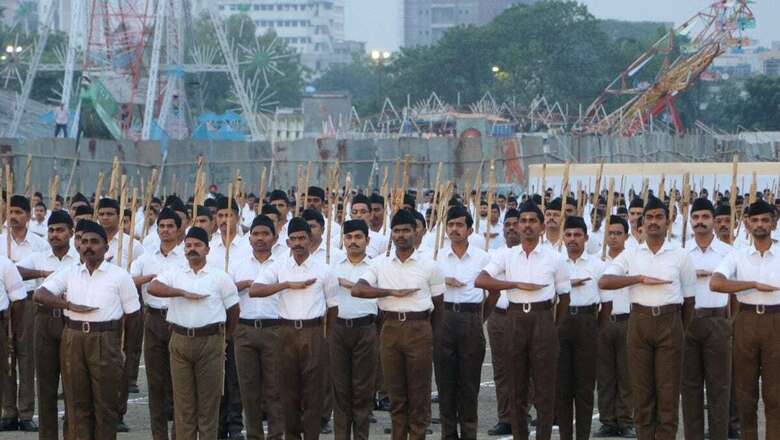
views
It’s a story of ‘grit and grace’ that defines the Hindu-centric Rashtriya Swayamsevak Sangh (RSS), whose centennial began poignantly on this Vijayadashami.
The momentous journey of the RSS began modestly during the independence struggle, with the aim of organising Hindus and instilling confidence in those identified as ‘Sanatana Dharmis,’ or followers of Sanatana Dharma.
In 1925, on the tenth day of Dussehra, which marks the victory of good over evil, the RSS was founded under the stewardship of Dr Keshav Baliram Hedgewar. Since then, it has metamorphosed into a gigantic movement, recognised as the largest non-governmental voluntary organisation or movement globally.
For many practising and non-practising Hindus, the RSS has remained an enigma for quite some time—both easily understood and misunderstood. Its unique work culture and selfless, volunteer-driven organisation draw strength from Bharat’s civilisational legacy, which has survived many upheavals and challenges.
In fact, RSS Sarsanghchalak Dr Mohan Bhagwat revealed the secret behind the sustained and organic growth of the organisation on this Vijayadashami, while referring to its centennial milestone at the Sangh’s sprawling ‘Reshim Bagh’ headquarters.
Dr Bhagwat identified ‘organised strength and national character’ as the two major components contributing to the growth of Bharat, Hindu society, and, in turn, the Sangh. With over 73,000 shakhas or branches, the Sangh today is a vast entity, encompassing a wide range of fellow Hindu organisations that form the ‘parivar’ or ‘larger family.’ With over 120,000 service projects under its belt and around 30,000 schools to its credit, Sangh swayamsevaks represent ‘selflessness, sacrifice, and courage.’
RSS shakhas, or basic organisational units, are spread across 63,000 mandals (clusters of 8–10 villages each) and are held in open spaces daily, which is what keeps the organisation dynamic. Additionally, over 28,000 weekly shakhas add another layer to these branches.
The Sangh proudly upholds its twin objectives of ‘man-making and character-building’ as its guiding principles and is steadily reaching out to over 100,000 villages. Along with the shakhas, the Sangh carries out service projects spanning healthcare, education, self-reliance, and socio-economic development in villages, semi-urban areas, and cities.
It’s difficult to fully grasp the reach of this organisation as it approaches its 100th anniversary in the coming months. The fact that Sangh swayamsevaks reached out to over 129 million families in 575,000 villages in just 40 days to mobilise resources and support for the construction of the Shri Ram temple in Ayodhya reflects its tenacity and influence among Hindus.
Many analysts are eager to know: what’s next for the RSS? One hundred years is quite a journey for any voluntary organisation, but RSS volunteers seem ready for the future!
Five transformative ideas put forth by the RSS Sarsanghchalak in his Vijayadashami speech provide a clear vision of the ‘big bang’ long-term issues the organisation seeks to address. From tackling environmental degradation to countering the erosion of Hindu family values, the focus appears to be on strengthening social bonds. Achieving social harmony, instilling a sense of ‘self-esteem,’ and fostering civic discipline in larger communities and society have been highlighted as new areas of work.
These ‘panch parivartan’ (five transformative ideas) were emphasised by the RSS chief while he outlined the broader, immediate challenges facing humanity. He identified significant threats posed by the ‘deep state,’ ‘wokeism,’ and ‘cultural Marxists,’ which he suggested were creating chaos in societies globally, and particularly in Bharat. He also referred to specific crises, such as the ongoing conflict between Hamas and Israel in West Asia and the coup in Bangladesh, which led to what he described as the virtual genocide of Hindus, during his key address.
From Bharat’s perspective, several key issues were highlighted by RSS Sarsanghchalak, particularly the shameful incidents of rape in various places, such as the RG Kar Hospital in Kolkata, which led to ongoing protests by doctors.
Dr Mohan Bhagwat also emphasised the ‘importance of being strong’ and united in the face of disturbances in Punjab, Jammu & Kashmir, Ladakh along the north-western borders, Kerala, the Tamil Nadu coast, and the entire north-eastern region, stretching from Bihar to Manipur. He rightly pointed out attempts being made by ‘divisive elements’ to create conflict.
Dr Bhagwat further addressed faith-based intolerance and the attempts to incite violence during festivals such as Ganesh Chaturthi, Durga Puja, and Ram Navami, stressing the need for strength and the importance of achieving harmony.
The Author is Director & Chief Executive, Centre for Integrated and Holistic Studies, New Delhi-based non-partisan think tank. Views expressed in the above piece are personal and solely those of the author. They do not necessarily reflect News18’s views.



















Comments
0 comment